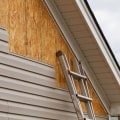Are you in need of Siding Repair near Folly Beach SC? Are you considering removing old siding and dealing with disposal fees? Whether you're planning on replacing your home's siding or just getting rid of old material, this process can be a daunting and costly one. In this article, we'll cover everything you need to know about removing old siding and disposal fees, from the average cost to potential additional expenses. Knowing what to expect can help you budget and plan accordingly, so let's get started!When it comes to updating the exterior of your home, new siding can make a big impact. Not only does it enhance the aesthetic appeal, but it also serves as a protective barrier against the elements. However, before you can install new siding, you'll need to remove the old siding first.
This process can come with additional expenses, such as disposal fees. In this article, we'll cover everything you need to know about removing old siding and the related costs. First, let's discuss the different types of siding available. Vinyl and fiber cement are two popular options, each with their own unique benefits. Vinyl siding is known for its affordability, low maintenance, and versatility in design.
It's also resistant to rot, insects, and extreme weather conditions. On the other hand, fiber cement siding is durable, fire-resistant, and can mimic the look of wood or masonry. It does require more maintenance and a higher upfront cost, but it can add value to your home in the long run. Now, let's dive into the cost of siding and how to determine which option is best for your budget and home. The cost of siding can vary depending on factors such as material, size of your home, and labor costs.
On average, vinyl siding can cost between $2-$7 per square foot, while fiber cement siding can range from $5-$12 per square foot. Keep in mind that these prices may not include additional expenses such as removing old siding and disposal fees. Which brings us to our main topic - removing old siding and disposal fees. The process of removing old siding can be time-consuming and labor-intensive. If you're considering a DIY project, keep in mind that you'll need the proper tools and equipment to safely remove the old siding without causing damage to your home.
It's also important to properly dispose of the old siding to avoid any potential environmental hazards. Disposal fees can vary depending on your location and the amount of waste being disposed of. Some areas may have specific regulations for disposing of construction debris, so it's important to check with your local waste management company beforehand. Additionally, some siding companies may offer disposal services as part of their package, so be sure to inquire about this before hiring a professional. In addition to disposal fees, there may be other additional expenses to consider when removing old siding. This can include the cost of renting a dumpster or hiring a hauling company to transport the waste.
It's important to factor in these costs when budgeting for your siding project. In conclusion, removing old siding and disposal fees are important factors to consider when planning for new siding installation. Whether you choose vinyl or fiber cement siding, it's crucial to properly remove and dispose of the old siding to ensure a smooth and successful project. We hope this article has provided valuable information to help you make informed decisions for your home improvement project.
Types of Siding and Their Benefits
Choosing the right type of siding for your home can be a daunting task. With so many options available, it can be overwhelming to make a decision.However, one of the most popular choices among homeowners is vinyl siding. Not only is it durable and low maintenance, but it is also affordable. Vinyl siding is made from PVC (polyvinyl chloride) resin, making it resistant to rot, moisture, and insects. This makes it a great option for areas with high humidity or extreme weather conditions. Additionally, vinyl siding requires very little maintenance. Unlike other types of siding that may need to be repainted or refinished, vinyl siding maintains its color and appearance over time.
A simple cleaning with a hose and mild soap is usually all that is needed to keep it looking like new. One of the biggest benefits of vinyl siding is its affordability. It is typically less expensive than other types of siding such as wood or brick, making it a budget-friendly option for homeowners. In summary, removing old siding and disposing of it properly is an important step in your home improvement journey. By understanding the different types of siding available, their benefits, and the cost involved, you can make an informed decision that fits your needs and budget. And don't forget to properly dispose of your old siding to avoid any additional fees!.






